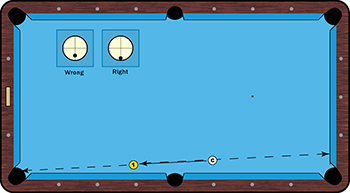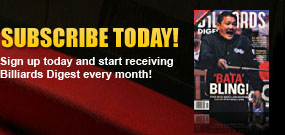Where you place your hands makes a big difference on draw shots.
Perfect practice isnít always about drills.
Sometimes, perfect practice means total focus on fundamentals and execution. The most common flaw in amateur players (and even lower-level pros) is a faulty stroke and execution.
Because so many amateurs struggle with drawing the cue ball, letís work on that this month.
Here are the most common problems I see with amateurs when it comes to drawing the cue ball:
- Hand position
- Contact point on the cue ball
- Hitting the ball too hard
- Stroke too quick
- Not bringing the cue ball far enough
- Not driving through the cue ball
- Tension in lower arm, shoulder and hand
- Bad timing and tempo
- Holding the cue in the wrong part of the butt
Most amateurs donít aim low enough on the cue ball. That could be because they are afraid of miscuing. That happens when your hand is too close to or too far away from the cue ball. Your tempo and timing get thrown off and your stroke becomes ďjabby.Ē Then you scoop the cue ball. I see that time and again.
Also, a lot of players donít hold the butt of the cue in the right spot and their forearm is not straight. That causes you to aim as shown in the ďwrongĒ cueing option. Striking the cue ball here requires you to hit the cue ball way too hard to get it to draw back to the short rail. The problem gets compounded by stabbing at the cue ball, moving your head, and having too much tension in your arms and shoulders and hands.
Aiming a little higher on the cue ball is fine if you just want to draw it a foot. You donít need to strike the ball as hard. And because your more comfortable with a short draw, youíre automatically more relaxed in the arms and mind.
Most of the problem is that your hand is either too far away (12 inches) from the cue ball or too close (6 inches or closer) to it. The problem here is that the distance affects your timing and tempo. If youíre too far from the cue ball, you run out of cue by the time you hit the cue ball. You lose timing and donít drive through the ball. If you are too close, you canít pull the cue far enough back and your stroke is too quick.
Letís do it the right way.

First, keep you forearm pointing straight down (for me, pointing towards my right foot). If you put your hand 8-10 inches from the cue ball (optimum distance), you will know exactly where your hand needs to be on the butt of your cue. If you are shorter, having your hand 6-8 inches from the cue ball is fine, as long as your forearm is pointing straight down where you grip the cue. This is critical for maintaining the proper timing and tempo. If your arm is not straight, it will cause your shoulder and arm to drop. If your arm is bent, you will also end up with a shovel stroke. You want your forearm and hand swinging back and forth on the same plane. Thatís what creates proper timing and tempo.
When practicing this, it sometimes helps to put markers on the table for training purposes. Finding the right distance from the cue ball is very important. Count to two on the backswing and the third count should be the follow through. Finish at least 3-4 inches past the cue ball. And remember, itís vital to maintain a loose grip, have no tension in your arm and keep your head still. This should allow you to hit the cue ball as low as possible (ďRightĒ). Along as your tip is chalked and you have good tempo, you donít have to worry about miscuing. The cue ball will draw back up table very easily with little effort.
Remember, find the right distance for you from the cue ball, use a loose grip and keep your forearm straight. If you do these three things, pull the cue back on a two count and swing on three, follow through and aim low on the cue ball, your draw shot will never be a problem. After a while, it will become second nature. Practice the shot as depicted in the diagram before every practice session.
And hereís a little tip for longer distance draw shots: I move my hand back on the butt 1-2 inches and move my bridge hand back the same distance from the cue ball. This allows me to generate more draw without hitting the ball any harder, which, in turn, allows me to keep my tempo and timing.
First, though, build confidence with short to midrange draw shots. Youíll learn a lot about your stroke and what itís capable of.





